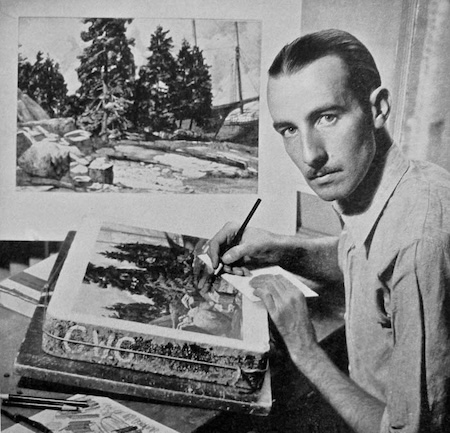Many people have asked me, “What brought you to Maine?”.
I begin explaining by mentioning my friend and mentor Stow Wengenroth.
Here he is in a photo from 1937 working on his lithograph, titled “Maine”. Stuckey #67, 1937, Boothbay Harbor, ME. The dry brush study he used for the litho can be seen propped against the wall. The lithograph itself was printed in an edition of 75 and is 10-5/8x15-5/16 inches. The finished lithograph is pictured below.
I enjoyed going out for breakfast when I lived in Rockport back in the 60’s & 70’s and my favorite place for breakfast was the Galley, run by Mike Parillo. Its re-opening every spring was a greatly anticipated event for me. Delicious food cooked to perfection, and if he wasn’t too busy, good conversation was a bonus. I would be at his door at opening time, 8am, nearly every day. As summer approached an older gentleman would begin to arrive and both of us being naturally quiet would merely acknowledge each other’s presence with a nod.
One morning, Mike was talking to him and had him sign a book. After the gentleman left, I was curious and asked Mike who he was. “Stow Wengenroth” and he brought me the book to look through. It was Stow Wengenroth’s New England. I was completely taken with his work and immediately bought a copy at the bookstore. The very next morning, I introduced myself to him and invited him back to my studio to see my drawings. He was very encouraging and over time we became friends. We met for breakfast most mornings while he was staying in Rockport and talked about art. He and his work became the single biggest influence on my own work and I owed him more than could ever be repaid for his encouragement and friendship. Nearly a decade after his death, We named our son after him.
Stow lived in Greenport, Long Island, NY during the winter, and traveled to Rockport and Maine for his summers. He spent many of his earlier years traveling by rail along the Maine coast, first in Eastport around 1932 and then to many of the other beautiful towns that have proven to be an inspiration to so many artists. One of the first trips my wife Pat and I took together was what I called a pilgrimage to the places that Stow had worked in. We started by driving straight from Gloucester to Eastport and then worked our way down the coast visiting as many of the towns as we could fit in our schedule. One of the towns was Castine, where we now live. Pictured below are three lithographs he produced from his stays in Castine.
An interesting side story is, after we moved to Castine we started attending the Castine Unitarian Church. As I sat in the pew and looked at the chandelier and surroundings, I suddenly felt I had been transported into a Wengenroth lithograph.
“Fog”, Castine, Maine, 1942, 8-3/16x15-1/4 inches, edition of 20
Below is a lithograph of a steam train crossing a marsh in Wiscasset.
The following was written by Carl Little for an article in Maine Boats Homes & Harbors.
“Gregory Dunham traces his passion for the working waterfront to the 1950’s when as a child his family drove through the back streets of Gloucester on the way to a vacation cottage at Long Beach. The colors, smells and sounds of the bustling harbor captivated him and set him on a course toward shoreline painting. A friend and mentor, master printmaker Stow Wengenroth, encouraged Dunham to explore the coast of Maine. After extended expeditions that included visits to Eastport, Lubec and Corea, he and his wife settled in Castine in 1987. Since then the painter has trained his eye primarily on waterfront subjects. In meticulous, light-filled watercolors, he renders the details of this world, be it propellor perched on sawhorses or skiffs pulled up on the beach at Monhegan.”
Until Stow’s death in 1977, I concentrated mostly on graphite drawings and only began lithography myself in 1979. This letter was sent to me about an exhibition of my drawings at the Rockport Art Association. The Harriet he mentions was Harriet Matson, then curator of the RAA and later his wife.
In the collections of The Museum of Fine Arts, Boston and Zimmerli Museum, Rutgers University
"Quiet Cove", Prince Cove, Eastport, ME
In the Collection of The Tides Institute and Museum of Art, Eastport, ME
This #11 Brush had belonged to Stow and came to me via Tom Nicholas, who had acquired many of Stow’s tools after his death. It sits next to me on my taboret, but has remained unused, since it came into my possession.
If you would like to learn more about Stow Wengenroth and his work, you can find the two definitive books by Ronald and Joan Stuckey , The Lithographs of Stow Wengenroth, 1931-1972 Boston Public Library in co-operation with Barre Publishers, 1974 and Stow Wengenroth’s Lithographs: A Supplement, Black Oak Publishers,1982. Also, you might be able to find a copy of the aforementioned Stow Wengenroth’s New England, by David McCord, Barre Publishers, 1969. There is a more extensive bibliography that you can probably find online.
Pictured below is Stow’s book “Making a Lithograph”, published in1936, The Studio Limited, London and The Studio Publications Inc., New York, NY












